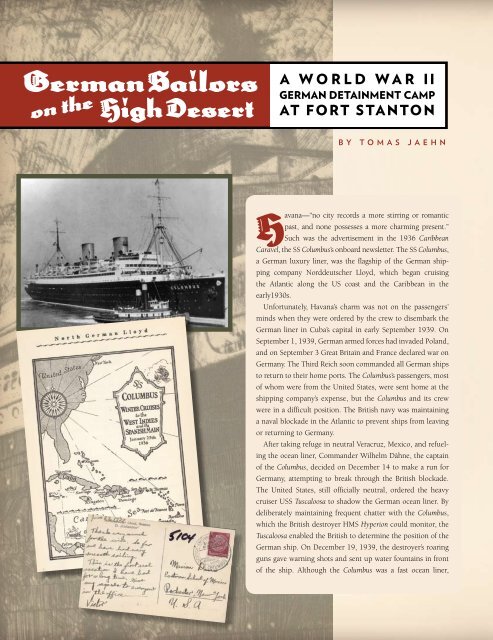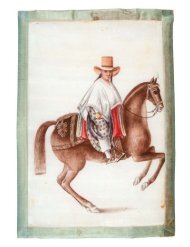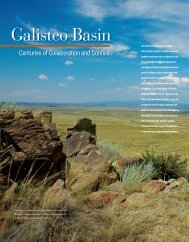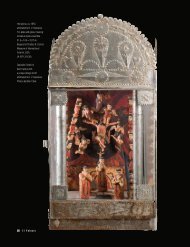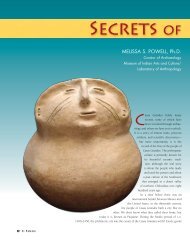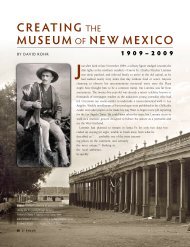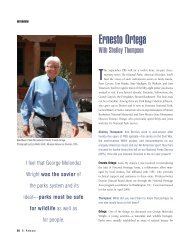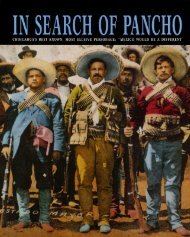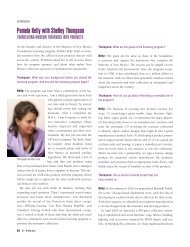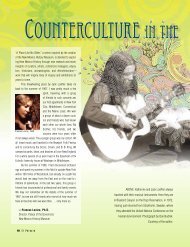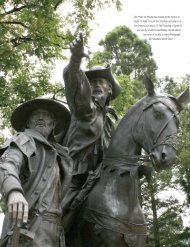German Sailors on the High Desert - El Palacio Magazine
German Sailors on the High Desert - El Palacio Magazine
German Sailors on the High Desert - El Palacio Magazine
You also want an ePaper? Increase the reach of your titles
YUMPU automatically turns print PDFs into web optimized ePapers that Google loves.
<str<strong>on</strong>g>German</str<strong>on</strong>g><str<strong>on</strong>g>Sailors</str<strong>on</strong>g><br />
<strong>High</strong><strong>Desert</strong><br />
<strong>on</strong> <strong>the</strong><br />
A World WAr II<br />
GErMAN dEtAINMENt CAMp<br />
At Fort StANtoN<br />
By Tomas Jaehn<br />
Havana—“no city records a more stirring or romantic<br />
past, and n<strong>on</strong>e possesses a more charming present.”<br />
Such was <strong>the</strong> advertisement in <strong>the</strong> 1936 Caribbean<br />
Caravel, <strong>the</strong> SS Columbus’s <strong>on</strong>board newsletter. The SS Columbus,<br />
a <str<strong>on</strong>g>German</str<strong>on</strong>g> luxury liner, was <strong>the</strong> flagship of <strong>the</strong> <str<strong>on</strong>g>German</str<strong>on</strong>g> shipping<br />
company Norddeutscher Lloyd, which began cruising<br />
<strong>the</strong> Atlantic al<strong>on</strong>g <strong>the</strong> US coast and <strong>the</strong> Caribbean in <strong>the</strong><br />
early1930s.<br />
Unfortunately, Havana’s charm was not <strong>on</strong> <strong>the</strong> passengers’<br />
minds when <strong>the</strong>y were ordered by <strong>the</strong> crew to disembark <strong>the</strong><br />
<str<strong>on</strong>g>German</str<strong>on</strong>g> liner in Cuba’s capital in early September 1939. On<br />
September 1, 1939, <str<strong>on</strong>g>German</str<strong>on</strong>g> armed forces had invaded Poland,<br />
and <strong>on</strong> September 3 Great Britain and France declared war <strong>on</strong><br />
<str<strong>on</strong>g>German</str<strong>on</strong>g>y. The Third Reich so<strong>on</strong> commanded all <str<strong>on</strong>g>German</str<strong>on</strong>g> ships<br />
to return to <strong>the</strong>ir home ports. The Columbus’s passengers, most<br />
of whom were from <strong>the</strong> United States, were sent home at <strong>the</strong><br />
shipping company’s expense, but <strong>the</strong> Columbus and its crew<br />
were in a difficult positi<strong>on</strong>. The British navy was maintaining<br />
a naval blockade in <strong>the</strong> Atlantic to prevent ships from leaving<br />
or returning to <str<strong>on</strong>g>German</str<strong>on</strong>g>y.<br />
After taking refuge in neutral Veracruz, Mexico, and refueling<br />
<strong>the</strong> ocean liner, Commander Wilhelm Dähne, <strong>the</strong> captain<br />
of <strong>the</strong> Columbus, decided <strong>on</strong> December 14 to make a run for<br />
<str<strong>on</strong>g>German</str<strong>on</strong>g>y, attempting to break through <strong>the</strong> British blockade.<br />
The United States, still officially neutral, ordered <strong>the</strong> heavy<br />
cruiser USS Tuscaloosa to shadow <strong>the</strong> <str<strong>on</strong>g>German</str<strong>on</strong>g> ocean liner. By<br />
deliberately maintaining frequent chatter with <strong>the</strong> Columbus,<br />
which <strong>the</strong> British destroyer HMS Hyperi<strong>on</strong> could m<strong>on</strong>itor, <strong>the</strong><br />
Tuscaloosa enabled <strong>the</strong> British to determine <strong>the</strong> positi<strong>on</strong> of <strong>the</strong><br />
<str<strong>on</strong>g>German</str<strong>on</strong>g> ship. On December 19, 1939, <strong>the</strong> destroyer’s roaring<br />
guns gave warning shots and sent up water fountains in fr<strong>on</strong>t<br />
of <strong>the</strong> ship. Although <strong>the</strong> Columbus was a fast ocean liner,
capable of a maximum speed of twenty-two knots, it was no<br />
match for <strong>the</strong> British destroyer.<br />
Captain Dähne’s choices were limited: ei<strong>the</strong>r scuttle <strong>the</strong> ship<br />
or turn it over to <strong>the</strong> British navy. While harboring in Mexico,<br />
<strong>the</strong> <str<strong>on</strong>g>German</str<strong>on</strong>g> crew had practiced many “dry runs” <strong>on</strong> how<br />
to quickly sink <strong>the</strong>ir ship. When <strong>the</strong> commander gave <strong>the</strong><br />
order, everybody knew what to do: valves were opened, fires<br />
were set, and explosives were det<strong>on</strong>ated in strategic places.<br />
The Columbus began to sink. Three sailors remained behind<br />
for unknown reas<strong>on</strong>s, but all <strong>the</strong> rest followed <strong>the</strong> captain’s<br />
ultimate order: “aband<strong>on</strong> <strong>the</strong> ship.” Five hundred seventy-six<br />
crew members climbed into lifeboats and <strong>the</strong>n watched from<br />
afar as <strong>the</strong> luxury liner of Norddeutscher Lloyd sank 12,000<br />
feet to <strong>the</strong> bottom of <strong>the</strong> Atlantic.<br />
It was left to <strong>the</strong> Tuscaloosa, whose crew watched <strong>the</strong> ship<br />
go down from a safe distance, to pick up <strong>the</strong> stranded <str<strong>on</strong>g>German</str<strong>on</strong>g><br />
seamen. Officially neutral in <strong>the</strong> European c<strong>on</strong>flict, <strong>the</strong> United<br />
States treated <strong>the</strong> <str<strong>on</strong>g>German</str<strong>on</strong>g>s as “distressed seamen” with routine<br />
permissi<strong>on</strong> to remain in <strong>the</strong> country for up to ninety days.<br />
Great Britain allowed female staffers <strong>on</strong> <strong>the</strong> ship to return<br />
home, but except for a few humanitarian cases, <strong>the</strong> civilian<br />
sailors were denied permissi<strong>on</strong> to repatriate. A few individual<br />
attempts to repatriate via Italy and later Japan were hindered<br />
by <strong>the</strong> British navy.<br />
LEFT: The SS Columbus was a luxury liner, taking tourists from East Coast port<br />
cities to <strong>the</strong> Caribbean. Photograph, brochure, and postcard courtesy of Tomas Jaehn.<br />
ABOVE: The <str<strong>on</strong>g>German</str<strong>on</strong>g> crew escapes <strong>the</strong> burning SS Columbus by ladders and lifeboats.<br />
These photographs were taken by sailors, and appeared in <strong>the</strong> January 1, 1940<br />
Life magazine. Courtesy Life magazine and James J. McBride.
38 E l <strong>Palacio</strong><br />
LEFT: The USS Tuscaloosa rescued <strong>the</strong> <str<strong>on</strong>g>German</str<strong>on</strong>g> sailors from <strong>the</strong>ir sinking ship.<br />
Commodore Harry Ascher Badt was recognized in c<strong>on</strong>temporary reports as <strong>the</strong><br />
Jewish officer who rescued sailors from Nazi <str<strong>on</strong>g>German</str<strong>on</strong>g>y. Courtesy Es<strong>the</strong>r Badt<br />
Balsamo and James J. McBride.<br />
BELOW: With impressive engineering skills <strong>the</strong> <str<strong>on</strong>g>German</str<strong>on</strong>g> sailors built <strong>the</strong>mselves a<br />
swimming pool in <strong>the</strong> New Mexico desert. Courtesy Immigrati<strong>on</strong> and Naturalizati<strong>on</strong><br />
Service and James J. McBride.
Britain’s refusal to let fighting-age <str<strong>on</strong>g>German</str<strong>on</strong>g>s return home<br />
put <strong>the</strong> United States in a legal dilemma. FBI director J.<br />
Edgar Hoover intervened with a “list of charges [against <strong>the</strong><br />
<str<strong>on</strong>g>German</str<strong>on</strong>g> seamen which] ranged from fanciful to puritanical”<br />
(as reported by John Joel Culley in Prologue). After m<strong>on</strong>ths<br />
of legal maneuvering between various US agencies, and stays<br />
by <strong>the</strong> sailors <strong>on</strong> <strong>El</strong>lis Island and <strong>the</strong>n Angel Island in San<br />
Francisco Bay, <strong>the</strong> decisi<strong>on</strong> was made in August 1940, with<br />
<strong>the</strong> assistance and acquiescence of Captain Dähne, to move <strong>the</strong><br />
remaining crew of about 400 <str<strong>on</strong>g>German</str<strong>on</strong>g> sailors to Fort Stant<strong>on</strong>,<br />
New Mexico. It was an isolated place, far from urban centers<br />
and nothing like <strong>the</strong> glamorous port cities between which<br />
<strong>the</strong>se sailors and crew had sailed for years.<br />
Fort Stant<strong>on</strong>, seven miles nor<strong>the</strong>ast of Capitan, had a colorful<br />
history before it became home to <strong>the</strong> <str<strong>on</strong>g>German</str<strong>on</strong>g> detainees.<br />
Named after Captain Henry W. Stant<strong>on</strong>, who was killed in a<br />
skirmish with Apache Indians in 1855, Fort Stant<strong>on</strong> was at<br />
<strong>the</strong> heart of <strong>the</strong> US Army’s campaigns against Apaches and<br />
Navajos. Aband<strong>on</strong>ed in 1861, it was reoccupied in 1863 and<br />
turned eventually into a resident military post housing <strong>the</strong><br />
famous Buffalo Soldiers in <strong>the</strong> late 1870s. During <strong>the</strong> waning<br />
years of <strong>the</strong> nineteenth century, Fort Stant<strong>on</strong> soldiers saw <strong>the</strong>ir<br />
share of c<strong>on</strong>flicts in <strong>the</strong> Indian wars and <strong>the</strong> Lincoln County<br />
War. Until 1896, when it was vacated, at <strong>on</strong>e time or ano<strong>the</strong>r it<br />
had hosted famous and infamous people like Billy <strong>the</strong> Kid, Kit<br />
Cars<strong>on</strong>, and John “Black Jack” Pershing. In 1899 Fort Stant<strong>on</strong><br />
became a Merchant Marine hospital (later renamed to United<br />
...<strong>the</strong> locati<strong>on</strong><br />
ensured that any<br />
pro-Nazi activties<br />
would be isolated<br />
in this ra<strong>the</strong>r l<strong>on</strong>ely<br />
part of New Mexico.<br />
States Public Health Service) for merchant marine patients suffering<br />
from tuberculosis.<br />
The decisi<strong>on</strong> to bring <strong>the</strong> Columbus crew to Fort Stant<strong>on</strong><br />
was driven in part by <strong>the</strong> fact that structures from an aband<strong>on</strong>ed<br />
Civilian C<strong>on</strong>servati<strong>on</strong> Corps camp were adjacent to<br />
<strong>the</strong> fort, a hospital was nearby, and <strong>the</strong> locati<strong>on</strong> ensured that<br />
any pro-Nazi activities would be isolated in this ra<strong>the</strong>r l<strong>on</strong>ely<br />
part of New Mexico. Thus, Fort Stant<strong>on</strong> became <strong>the</strong> first<br />
United States civilian internment camp of World War II. In<br />
late January 1941, under <strong>the</strong> watchful eyes of Border Patrol<br />
officers, <strong>the</strong> first c<strong>on</strong>tingent of thirty-nine <str<strong>on</strong>g>German</str<strong>on</strong>g> seamen<br />
detrained Sou<strong>the</strong>rn Pacific Railroad railcars in Carrizozo, <strong>the</strong><br />
<strong>El</strong> <strong>Palacio</strong> 39
The <str<strong>on</strong>g>German</str<strong>on</strong>g> detainees worked <strong>on</strong> c<strong>on</strong>structi<strong>on</strong> and agricultural projects at Fort Stant<strong>on</strong>. New Mexico <strong>Magazine</strong><br />
Collecti<strong>on</strong>, Courtesy Palace of <strong>the</strong> Governors Photo Archives (NMHM/DCA), Neg. No. HP.2007.20.320.<br />
seat of Lincoln County. A small crowd of town folks watched<br />
<strong>the</strong>ir arrival. Dressed in civilian clo<strong>the</strong>s, <strong>the</strong> seamen quickly<br />
c<strong>on</strong>tinued <strong>the</strong>ir trip to Fort Stant<strong>on</strong>. Captain Dähne and<br />
his senior staff assigned bunkmates and job resp<strong>on</strong>sibilities.<br />
The camp needed accommodati<strong>on</strong>s, and <strong>the</strong> <str<strong>on</strong>g>German</str<strong>on</strong>g>s went<br />
to work to prepare for <strong>the</strong> so<strong>on</strong>-to-arrive additi<strong>on</strong>al detainees<br />
from <strong>the</strong> Columbus. They c<strong>on</strong>structed four barracks,<br />
a kitchen, laundry, mess hall, lavatories and washrooms,<br />
shops, officers’ quarters, and a medical dispensary. A little<br />
less than a m<strong>on</strong>th later, forty more <str<strong>on</strong>g>German</str<strong>on</strong>g>s arrived at Fort<br />
Stant<strong>on</strong> and joined in c<strong>on</strong>structing workspaces for <strong>the</strong> barbers,<br />
tailors, and o<strong>the</strong>r specialized crewmen who had staffed<br />
<strong>the</strong> Columbus.<br />
On March 17, 1941, <strong>the</strong> remaining 331 Columbus seamen<br />
arrived at Fort Stant<strong>on</strong>. After m<strong>on</strong>ths in <strong>the</strong> United States,<br />
many detainees were homesick. In an interview with James<br />
McBride, <strong>on</strong>e sailor, Rolf Kahlbenn, recalled that “we were<br />
in a way disappointed” by <strong>the</strong> desolate landscape surrounding<br />
Fort Stant<strong>on</strong>. At <strong>the</strong> fort, <strong>the</strong> American guards and<br />
<str<strong>on</strong>g>German</str<strong>on</strong>g> detainees lived toge<strong>the</strong>r under similar c<strong>on</strong>diti<strong>on</strong>s,<br />
40 E l <strong>Palacio</strong><br />
but authority was clearly divided. The Americans maintained<br />
<strong>the</strong> outside organizati<strong>on</strong>, and <strong>the</strong> <str<strong>on</strong>g>German</str<strong>on</strong>g>s, under <strong>the</strong> command<br />
of Captain Dähne, c<strong>on</strong>trolled <strong>the</strong> inside of <strong>the</strong> camp.<br />
To keep <strong>the</strong> detainees occupied, Captain Dähne ordered<br />
<strong>the</strong>m to get <strong>the</strong> camp tidy. The men painted buildings, planted<br />
trees, grew gardens, and landscaped <strong>the</strong> entire camp grounds.<br />
Whitewashed rocks marked <strong>the</strong> foot paths and roads; trees<br />
and bushes were transplanted from <strong>the</strong> nearby hills. They<br />
tried to make <strong>the</strong>ir place as homey as possible. The seamen<br />
built <strong>on</strong>e-room cabins with small garden plots al<strong>on</strong>g <strong>the</strong> Rio<br />
B<strong>on</strong>ito, where, during <strong>the</strong>ir time off, <strong>the</strong>y would read, relax,<br />
play cards, or pursue o<strong>the</strong>r hobbies. Except for <strong>the</strong> extraordinary<br />
circumstances of internment, <strong>the</strong>se activities were not<br />
unlike relaxing weekend activities back home in Schrebergärten<br />
(tiny community garden plots established for recreati<strong>on</strong>al use<br />
<strong>on</strong> <strong>the</strong> fringes of larger cities).<br />
To bring relative normalcy to this disc<strong>on</strong>certing situati<strong>on</strong>,<br />
Dähne obtained some farmland for <strong>the</strong> detainees, where <strong>the</strong>y<br />
produced vegetables and potatoes—enough for <strong>the</strong> camp plus<br />
surplus that <strong>the</strong>y were allowed to sell <strong>on</strong> <strong>the</strong> open market for
profit. Because <str<strong>on</strong>g>German</str<strong>on</strong>g>y and <strong>the</strong> United States were still officially<br />
at peace, <strong>the</strong> detainees were allowed —with permissi<strong>on</strong><br />
from <strong>the</strong> guards—to go to Capitan, <strong>the</strong> nearest community,<br />
take hikes into <strong>the</strong> mountains, or stroll al<strong>on</strong>g <strong>the</strong> Rio B<strong>on</strong>ito.<br />
Occasi<strong>on</strong>ally, when additi<strong>on</strong>al medical attenti<strong>on</strong> was needed,<br />
detainees were able to travel sixty miles to Roswell, <strong>the</strong> <strong>on</strong>ly<br />
good-sized town nearby.<br />
Dähne was able to purchase older Model T Ford trucks to<br />
start a driving school, and daily training was c<strong>on</strong>ducted both<br />
in <strong>the</strong> classroom and <strong>on</strong> <strong>the</strong> driving field. The camp operated<br />
its own library with books in English and in <str<strong>on</strong>g>German</str<strong>on</strong>g> purchased<br />
from farm and arts and craft surplus sales. In lieu of a<br />
camp newspaper, Dähne aired short newsclips in <strong>the</strong> evenings<br />
over a loudspeaker system. Some detainees later remembered<br />
well <strong>the</strong> weekly movie and classes in European languages.<br />
The social center of <strong>the</strong> camp was <strong>the</strong> canteen, where <strong>the</strong><br />
men could purchase cigarettes, candy, cakes, ice cream, and<br />
o<strong>the</strong>r pers<strong>on</strong>al items as well as soft drinks and even homebrewed<br />
beer (two bottles per day was <strong>the</strong> official limit).<br />
Special orders, with <strong>the</strong> canteen staff as go-between, provided<br />
<strong>the</strong> detainees with seeds, chickens, and o<strong>the</strong>r “exotic” items.<br />
The detainees enjoyed music, weekly movies, and language classes. New<br />
Mexico <strong>Magazine</strong> Collecti<strong>on</strong>, Courtesy Palace of <strong>the</strong> Governors Photo Archives<br />
(NMHM/DCA), Neg. No. HP.2007.20.322.<br />
Pris<strong>on</strong>ers of War aT<br />
rosWell, neW mexico<br />
In May 1943, Roswell, New Mexico, became<br />
home to about 4,000 <str<strong>on</strong>g>German</str<strong>on</strong>g> pris<strong>on</strong>ers of<br />
war and an administrative base camp to<br />
many more who worked and lived <strong>on</strong> farms across<br />
sou<strong>the</strong>rn New Mexico under Roswell’s supervisi<strong>on</strong>.<br />
Camp Roswell was <strong>the</strong> first World War II POW<br />
camp outside <strong>the</strong> sou<strong>the</strong>rn part of <strong>the</strong> United States.<br />
Initially, many New Mexicans were agitated by <strong>the</strong><br />
idea of <str<strong>on</strong>g>German</str<strong>on</strong>g> POWs am<strong>on</strong>g <strong>the</strong>m. While <strong>the</strong> presence<br />
of <strong>the</strong> Fort Stant<strong>on</strong> detainees triggered <strong>on</strong>ly an<br />
occasi<strong>on</strong>al newspaper article, Roswell citizens wrote<br />
c<strong>on</strong>cerned letters to <strong>the</strong>ir senators and <strong>the</strong> local newspaper<br />
urging that <strong>the</strong> pris<strong>on</strong>ers be safely c<strong>on</strong>tained.<br />
Unlike <strong>the</strong> detainees at Fort Stant<strong>on</strong>, who worked<br />
voluntarily and, in a limited sense, for profit, <strong>the</strong><br />
POWs at Camp Roswell were required to work and<br />
were paid an hourly or daily wage that did not compete<br />
with <strong>the</strong> federal minimum wage. Because most<br />
uni<strong>on</strong>s representing carpenters, plumbers, and miners<br />
c<strong>on</strong>sidered POW laborers a threat to <strong>the</strong>ir professi<strong>on</strong>,<br />
<strong>the</strong> pris<strong>on</strong>ers, with few excepti<strong>on</strong>s, worked in<br />
agriculture and <strong>on</strong> ditches and acequias. Did <strong>the</strong> Fort<br />
Stant<strong>on</strong> detainees and <strong>the</strong> Roswell POWs have any<br />
c<strong>on</strong>tact with each o<strong>the</strong>r, or even know about each<br />
o<strong>the</strong>r’s presence in New Mexico? N<strong>on</strong>e of <strong>the</strong> sources<br />
c<strong>on</strong>sulted for this article record any interacti<strong>on</strong><br />
between <strong>the</strong>se two groups of <str<strong>on</strong>g>German</str<strong>on</strong>g>s. n<br />
The sailors built a swimming pool fed by spring water and<br />
maintained by a purifying system designed by <strong>the</strong> seafaring<br />
detainees. During <strong>the</strong> fall of 1941, <strong>the</strong> camp c<strong>on</strong>ducted its<br />
own Olympiad, using tennis courts, a soccer field, and tracks<br />
that <strong>the</strong> seamen built for recreati<strong>on</strong>. In short, <strong>the</strong> <str<strong>on</strong>g>German</str<strong>on</strong>g>s<br />
adjusted to <strong>the</strong>ir situati<strong>on</strong> as best <strong>the</strong>y could, and <strong>the</strong>ir camp<br />
resembled a small, well-functi<strong>on</strong>ing town. <str<strong>on</strong>g>German</str<strong>on</strong>g>y’s diplomatic<br />
representative in <strong>the</strong> United States, <strong>the</strong> Swiss legati<strong>on</strong>,<br />
and <strong>the</strong> Internati<strong>on</strong>al Red Cross, which occasi<strong>on</strong>ally inspected<br />
<strong>the</strong> camp for any violati<strong>on</strong>s of <strong>the</strong> Geneva C<strong>on</strong>venti<strong>on</strong><br />
(to which both <strong>the</strong> US and <str<strong>on</strong>g>German</str<strong>on</strong>g>y were signatories), were<br />
mostly satisfied with <strong>the</strong> detainees’ facilities and morale.<br />
<strong>El</strong> <strong>Palacio</strong> 41
One observer pointed out that, aside from <strong>the</strong> shared tasks<br />
of communal living, <strong>the</strong> seamen operated with <strong>the</strong> same organizati<strong>on</strong>al<br />
structure at <strong>the</strong> camp that <strong>the</strong>y had had <strong>on</strong> board<br />
<strong>the</strong> Columbus, with each man retaining his rank and duties.<br />
The cooks cooked, <strong>the</strong> tailors sewed, <strong>the</strong> barber cut hair, and<br />
<strong>the</strong> members of <strong>the</strong> ship’s orchestra gave c<strong>on</strong>certs, while <strong>the</strong><br />
senior officers administered and maintained <strong>the</strong> camp, with<br />
Captain Dähne serving as <strong>the</strong> official c<strong>on</strong>tact to <strong>the</strong> American<br />
camp administrati<strong>on</strong>.<br />
This relatively harm<strong>on</strong>ious way of life all changed <strong>on</strong><br />
December 9, 1941, two days after Pearl Harbor, when<br />
<str<strong>on</strong>g>German</str<strong>on</strong>g>y declared war <strong>on</strong> <strong>the</strong> United States. Any hopes that<br />
<strong>the</strong> detainees may have harbored of being home by Christmas<br />
were dashed. For two l<strong>on</strong>g years since <strong>the</strong> sinking of <strong>the</strong>ir<br />
ocean liner, <strong>the</strong> seamen had l<strong>on</strong>ged to go home, but with <strong>the</strong><br />
United States entering <strong>the</strong> war, <strong>the</strong> <str<strong>on</strong>g>German</str<strong>on</strong>g> seamen turned<br />
from detainees or “distressed seamen” into alien enemies,<br />
bound to remain in <strong>the</strong> United States for <strong>the</strong> foreseeable<br />
future. The commander of <strong>the</strong> Western Defense Command<br />
ordered wire fencing to enclose <strong>the</strong> camp, guard towers<br />
erected, guard dogs brought in, and <strong>the</strong> compound covered<br />
by floodlights. And although <strong>the</strong> <str<strong>on</strong>g>German</str<strong>on</strong>g>s declined <strong>the</strong><br />
42 E l <strong>Palacio</strong><br />
administrati<strong>on</strong>’s request to help build <strong>the</strong> detenti<strong>on</strong> center, it<br />
was operati<strong>on</strong>al as a pris<strong>on</strong> by early February 1942.<br />
By August 1943 <strong>the</strong> camp held 652 <str<strong>on</strong>g>German</str<strong>on</strong>g> detainees, having<br />
absorbed over time seamen from <str<strong>on</strong>g>German</str<strong>on</strong>g> ships that had<br />
met a fate like that of <strong>the</strong> Columbus, and a small “Segregati<strong>on</strong><br />
Camp” for difficult detainees. The camp c<strong>on</strong>tinued its internal<br />
organizati<strong>on</strong> under Captain Dähne but saw itself turn into a<br />
pro–Nati<strong>on</strong>al Socialist (Nazi) detenti<strong>on</strong> facility. Those of anti-<br />
Nazi persuasi<strong>on</strong> were transferred elsewhere. The camp administrati<strong>on</strong><br />
had always sensed that <strong>the</strong> crew of <strong>the</strong> Columbus had<br />
pro-Nazi sentiments, but it wasn’t clear if <strong>the</strong>ir attitudes were<br />
simply nati<strong>on</strong>alistic feelings about <strong>the</strong> Vaterland. The Columbus<br />
detainees had arrived during a time when Hitler’s <str<strong>on</strong>g>German</str<strong>on</strong>g>y<br />
was ascending, whereas later arrivals, disillusi<strong>on</strong>ed by years of<br />
war, had a different perspective. The camp administrati<strong>on</strong> did<br />
not attempt to Americanize <strong>the</strong> str<strong>on</strong>g-willed Wilhelm Dähne<br />
and his crew, but rules changed, and many were added for<br />
<strong>the</strong> former distressed seamen, now c<strong>on</strong>sidered alien enemies,<br />
at Fort Stant<strong>on</strong>. Day passes were highly regulated, lightsout<br />
requirements implemented, and curfew hours enacted,<br />
and <strong>the</strong> seamen’s access to salvageable items at Fort Stant<strong>on</strong><br />
was severely restricted. The l<strong>on</strong>g internment and <strong>the</strong> flux of
OPPOSITE LEFT: The detainees’ dining hall at Fort Stant<strong>on</strong>. New Mexico<br />
<strong>Magazine</strong> Collecti<strong>on</strong>, Courtesy Palace of <strong>the</strong> Governors Photo Archives (NMHM/<br />
DCA), Neg. No. HP.2007.20.321.<br />
<str<strong>on</strong>g>German</str<strong>on</strong>g> seamen coming and going based <strong>on</strong> <strong>the</strong>ir political<br />
points of view took <strong>the</strong>ir toll <strong>on</strong> <strong>the</strong> detainees. There were<br />
occasi<strong>on</strong>al minor squabbles, and <strong>the</strong> camp experienced <strong>on</strong>e<br />
major fight am<strong>on</strong>g <strong>the</strong> <str<strong>on</strong>g>German</str<strong>on</strong>g>s over Nazi allegiance. Some of<br />
<strong>the</strong> troublemakers were sent to <strong>the</strong> brig; o<strong>the</strong>rs were quickly<br />
transferred out of <strong>the</strong> camp. There were also occasi<strong>on</strong>al escape<br />
attempts. Detainees climbed fences, walked off work details,<br />
or dug tunnels, but all escapees were promptly caught and<br />
returned to camp. The futility of <strong>the</strong>se escape attempts became<br />
apparent <strong>on</strong>ce <strong>the</strong> escapees left <strong>the</strong> camp: <strong>the</strong>y were clueless<br />
about where to go when faced with <strong>the</strong> high mountains, forbidding<br />
deserts, and open spaces; for <strong>the</strong> sailors this was a<br />
landscape where, in <strong>the</strong> words of Gertrude Stein, “<strong>the</strong>re is no<br />
<strong>the</strong>re <strong>the</strong>re.”<br />
The Fort Stant<strong>on</strong> internees had to wait until <strong>the</strong> end of <strong>the</strong><br />
war to return to <str<strong>on</strong>g>German</str<strong>on</strong>g>y. Not all made it, though. Four seamen<br />
are buried at Fort Stant<strong>on</strong>: two died during a trichinosis<br />
epidemic in <strong>the</strong> camp, <strong>on</strong>e seaman hung himself, and <strong>on</strong>e was<br />
murdered (charges were dropped after it was determined that<br />
all participants were highly inebriated during what turned out<br />
to be a simple disagreement). Up<strong>on</strong> armistice, <strong>on</strong> May 8, 1945,<br />
<strong>the</strong> <str<strong>on</strong>g>German</str<strong>on</strong>g>s prepared for <strong>the</strong>ir l<strong>on</strong>g trip home, and <strong>on</strong> August<br />
27 <strong>the</strong> last internees left Carrizozo, leaving behind a small<br />
number of Japanese internees from <strong>the</strong> Japanese Internment<br />
Camp in Santa Fe to dismantle <strong>the</strong> site. On October 10, 1945,<br />
<strong>the</strong> camp was officially closed and ownership returned to <strong>the</strong><br />
US Public Health Service.<br />
LEFT/BELOW: The ruins of <strong>the</strong> gymnasium, which <strong>the</strong> internees<br />
built next to <strong>the</strong>ir swimming pool, remain at Fort Stant<strong>on</strong> today,<br />
with <strong>the</strong> original inscripti<strong>on</strong>, “Erbaut 1944” (“Built 1944”), over <strong>the</strong><br />
door. Photographs by David L. Tremblay.<br />
All that remains of <strong>the</strong> <str<strong>on</strong>g>German</str<strong>on</strong>g> camp are three rundown<br />
shacks, four grave sites, and <strong>the</strong> ruins of <strong>the</strong> gymnasium and<br />
<strong>the</strong> pool built by <strong>the</strong> <str<strong>on</strong>g>German</str<strong>on</strong>g>s. Few remember today that 400<br />
<str<strong>on</strong>g>German</str<strong>on</strong>g> seamen of <strong>the</strong> SS Columbus spent five years at Fort<br />
Stant<strong>on</strong> waiting to return home. n<br />
Tomas Jaehn is a historian who works as archivist and librarian at <strong>the</strong> Fray<br />
Angélico Chávez History Library.<br />
Investigate and Explore Fort Stant<strong>on</strong><br />
This essay c<strong>on</strong>cludes our three-part series <strong>on</strong> Fort Stant<strong>on</strong>. The entire series is <strong>on</strong>line<br />
at elpalacio.org. Fort Stant<strong>on</strong> is open for visitors, and <strong>the</strong> museum includes exhibits<br />
<strong>on</strong> <strong>the</strong> <str<strong>on</strong>g>German</str<strong>on</strong>g> internment camp. The camp site and <strong>the</strong> ruins of <strong>the</strong> swimming<br />
pool and gymnasium can <strong>on</strong>ly be visited with a tour guide. For informati<strong>on</strong> call <strong>the</strong><br />
museum at 575-336-1436.<br />
Sources: Very little has been written about <strong>the</strong> SS Columbus crew’s time at Fort<br />
Stant<strong>on</strong>. This essay relied <strong>on</strong> Wilfred McCormick, “Anchors Away,” New Mexico<br />
<strong>Magazine</strong> (June 1941), and a few c<strong>on</strong>temporary newspaper articles (New York Times,<br />
Lincoln County News, Roswell Daily Record, Albuquerque Journal). Sec<strong>on</strong>dary<br />
sources drawn <strong>on</strong> were James McBride’s <strong>the</strong>sis, “The Internment of <strong>the</strong> SS Columbus<br />
Crew during World War II” (1996); his subsequently published photo documentary,<br />
Interned: Internment of <strong>the</strong> S.S. Columbus Crew at Fort Stant<strong>on</strong>, New Mexico,<br />
1941–1945 (2003); John Joel Culley’s “A Troublesome Presence: World War II<br />
Internment of <str<strong>on</strong>g>German</str<strong>on</strong>g> <str<strong>on</strong>g>Sailors</str<strong>on</strong>g> in New Mexico” (Prologue, winter 1996); <strong>the</strong> Fray<br />
Angélico Chávez History Library’s clipping file <strong>on</strong> Fort Stant<strong>on</strong>; and various <str<strong>on</strong>g>German</str<strong>on</strong>g><br />
and English <strong>on</strong>line sources such as Radio Bremen TV’s documentary informati<strong>on</strong> <strong>on</strong><br />
<strong>the</strong> SS Columbus.<br />
<strong>El</strong> <strong>Palacio</strong> 43


